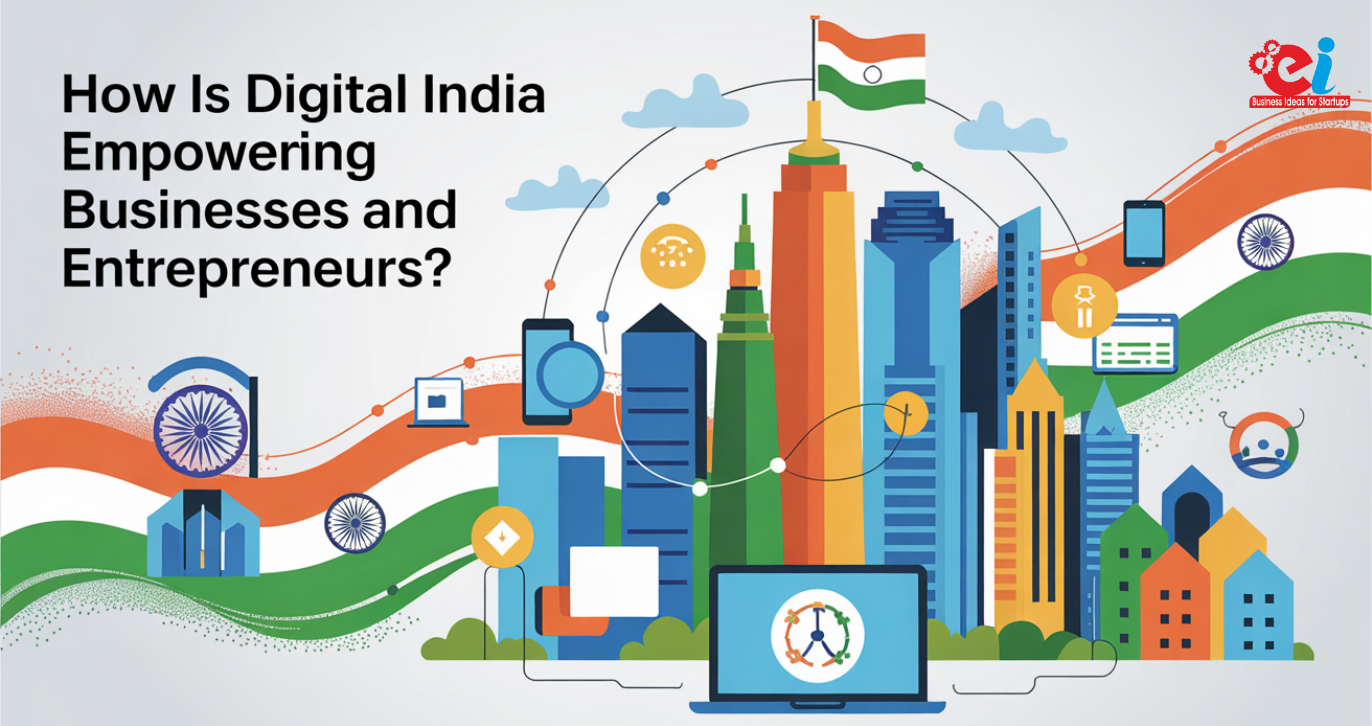India initiated its digital transformation a decade ago with the launch of the ‘Digital India’ program in 2015. This program is meant for digital infrastructure and digital literacy among the masses. Very few windows of opportunity have opened to grow, innovate, and remain competitive on a global level.
The Vision of Digital India
Digital India was launched with the vision of transforming India into a digitally empowered society and knowledge economy. It is based on three key pillars:
• Digital infrastructure provides broadband highways and secure digital identities.
• Governance and services enhance government offerings for citizens. Digital empowerment fosters citizen engagement.
• Digital infrastructure enables broadband highways and a secure digital identity.
These pillars create an excellent ground for the accelerated digital transformation of businesses and entrepreneurs across India.
Digital India: An Enabler for Entrepreneurs
1. Digital Payments and Financial Inclusion:
- Digital India has placed significant emphasis on digital payment systems, leading to the rapid adoption of methods like UPI (Unified Payments Interface) and BHIM (Bharat Interface for Money).
- Additionally, the rise of mobile wallets such as Paytm and Google Pay has enabled businesses to operate with minimal cash transactions.
- Digital India, with so much emphasis on digital payment systems, has resulted in almost the fastest adoption of a digital payment method like UPI and made it possible for businesses to do business without much cash.
- This extension of government-inspired financial inclusion, such as Jan Dhan Yojana and Aadhaar-based payment systems, allows micro-industry access to banking and credit services.
2. E-Governance and Ease of Doing Business
- This promotes the ease with which start-ups can apply for government benefits and available registrations.
- This helps tackle tax compliance more effectively and ensures transparency at the same time.
- MCA21 – online registering companies and filing compliance through the Ministry of Corporate Affairs portal.
- A government e-marketplace in which businesses provide their goods to government departments.
Indeed, such a digital platform has turned out to be helpful to remove the associated paperwork, corruption, and bureaucratic hurdles that stop India from becoming more entrepreneur-friendly.
3. Getting into Digital Marketing and E-Commerce
- For an entrepreneur’s promotion, digital marketing has been the key, from high-speed internet to affordable smartphones. An individual would reach the smallest small business to enter a global audience with social media like Facebook, Instagram, LinkedIn, and YouTube.
- Having such platforms for e-commerce as Amazon, Flipkart, and Meesho, small retailers, resellers, and artisans have easily converted into online merchants. Fair competition and digital retailing are also being supported by government programs like the Open Network for Digital Commerce (ONDC).
Read our Blogs: Start a Profitable Lead Recovery Business from Scrap Batteries
4. Digital Skilling and Development of Workforce
- Both government and private sectors offer various digital skill programs like PMGDISHA and Skill India Mission.
- These programs provide training in digital marketing, coding, AI, and cybersecurity, helping individuals start their own businesses or enhance job opportunities. Both the government and private sectors had different digital skill programs for taking individuals in the clutches of technology.
- This range of the PMGDISHA (Pradhan Mantri Gramin Digital Saksharta Abhiyan) Program, Skill India Mission, etc., imparts training on digital marketing, coding, AI, and cybersecurity and empowers people to start their own business or at least get improved job opportunities.
- Be that as it may, there are other online platforms, such as Udemy, Coursera, NPTEL, etc., that assist the entrepreneur in being a one-stop destination for new skills and updates on current happenings.
5. Internet Connectivity and Empowerment of Rural Areas
- India Broadband has succeeded very much in mitigating the urban-rural differential concerning the penetration of high-tech systems in some of the most remote corners of India.
- Agribusiness entrepreneurs, including farmers and agribusinesses, can access digital platforms for marketing, weather, and financial support.
- Handicrafts/cottage industries: Digital marketplace for artisans to earn better income from the sale.
- Freelancers and remote employment: Rural-based youth may find opportunities online related to content writing, graphic design, IT services, etc.
6. Innovative Technology Startups
- The Indian startup ecosystem has massively advanced under the Digital India initiative. It advances concrete funding for start-ups through initiatives like Startup India, Atal Innovation Mission (AIM), and Incubation Centers, and it also includes mentorship and incubation facilities.
- Not that these had ever been lacking in the past, but technology-driven innovative solutions have sprung up in many areas—natural banking itself, edtech, healthtech, and agritech. Startups that have taken advantage of digital technologies for a scalable and high-impact solution include Paytm, BYJU’s, Zerodha, and Ninjacart.
Difficulties and the Road Ahead
Digital India has revolutionized the business but has brought up some problems still to be resolved:
- Digital Divide: More connectivity, especially in rural areas, is still very poor despite an increase in Internet penetration.
- Cybersecurity Threats: More use of digital payments made the country amply exposed to cybercrime and necessities for privacy protection.
- Skill Gaps: Programs targeting more specifically immersive trainings will help cater to advanced digital skill requirements by the workforce.
- Infrastructure Development: It is essential to upgrade or get rid of the inefficient infrastructures created in digital cities, most especially Tier 2 and Tier 3 so that digital use will become popular.
- To sustain the adoption of digital solutions, there needs to be joint work between policymakers, private sector organizations, and entrepreneurs.
Concluding Thoughts
Digital India has transformed business operations and created numerous opportunities for entrepreneurs. With advancements in e-commerce, digital payment systems, and startup support, India is becoming a hub for digital transformation. The initiative aims to foster inclusive growth and economic prosperity for everyone. In addition to changing how businesses operate, Digital India has created countless opportunities for both entrepreneurs and businesses. Whether it is the quick development of e-commerce skills, the rise of digital payment systems, or startup support, all of these factors combine to make India a digital transformation paradise on its terms. With sheer advancement and omnipresent strategic policies, thus, the forum will be playing a role in shaping the future of business in Digital India. It aims towards inclusive growth and economic prosperity for one and all.










